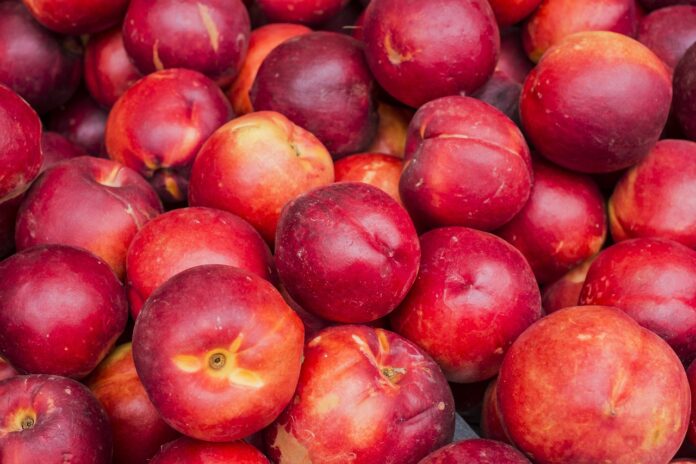Nectarines are a smooth-skinned variety of peach (Prunus persica var. nucipersica), known for their juicy and sweet-tart flavor. They are distinguished from traditional peaches by their lack of fuzz, which results from a genetic mutation. Despite this difference in skin texture, nectarines and peaches share nearly identical genetic profiles and can even grow on the same tree through grafting or naturally occurring bud mutations.
Interesting Facts About Nectarine:
- Smooth Skin Difference: The primary physical difference between nectarines and peaches is their skin. Nectarines are smooth and hairless, while peaches have a fuzzy exterior. This trait is due to a single recessive allele for smooth skin in nectarines, while peaches have a dominant allele for fuzz. Both fruits belong to the same species, Prunus persica.
- Origin and Cultivation: Nectarines were first grown in China over 2,000 years ago, where they are deeply rooted in agricultural history. They eventually spread through trade routes, reaching Persia and Europe. Today, China continues to be the top global producer, followed by major cultivators like Spain, Italy, and the United States. The fruit’s genetic variation has made it well-suited to various climates.
- Nectar Myth: The term “nectarine” derives from “nectar,” referring to the drink of the gods in Greek mythology, signifying the fruit’s heavenly sweetness. This reference highlights how the juicy, fragrant fruit was regarded as a divine indulgence.
- Stone Fruit Family: Nectarines belong to the Rosaceae family, which also includes cherries, apricots, and almonds. The hard pit or “stone” in the center houses a seed, and the fruits are classified based on whether their flesh clings to or easily separates from the stone, known as clingstone or freestone varieties.
- Rosaceae Relation: This botanical family includes not only nectarines and peaches but also flowering plants like roses. The shared lineage is evident in the similar fragrance profile, and both nectarines and roses produce aromatic compounds that attract pollinators.
- Flesh Colors: Varieties of nectarines feature either yellow or white flesh, with each type offering a unique flavor profile. Yellow-fleshed nectarines are generally tart with a hint of sweetness, while white-fleshed ones are sweeter and less acidic. The color also indicates antioxidant content, which contributes to health benefits.
- Ripening Process: Unlike fruits that change color significantly, nectarines are tricky to judge for ripeness based solely on appearance. The best indicators are a fragrant aroma and slight give when pressed gently. Unripe nectarines can be left at room temperature to ripen naturally, enhancing their sweetness.
- Seasonal Availability: The peak season for nectarines is during the summer months. In regions like California, where most U.S. nectarines are grown, the warm, sunny climate provides the ideal conditions for their cultivation, ensuring high sugar content and juicy flesh.
- Nutritional Benefits: Besides being rich in vitamins A and C, nectarines are also loaded with dietary fiber, which supports digestion, and potassium, which aids in heart health. The antioxidants present in nectarines, such as beta-carotene and polyphenols, help neutralize harmful free radicals.
- Fiber Content: The dietary fiber in nectarines is beneficial for digestive health, helping to prevent constipation and support gut microbiota. A medium-sized nectarine provides around 2.2 grams of fiber, contributing to daily nutritional needs and promoting satiety.
- No Need to Peel: Nectarine skin is edible and provides additional fiber and nutrients, making the fruit a convenient and healthy snack. The smooth, thin skin is also less prone to pesticide absorption compared to fuzzier fruits, making them easier to wash clean.
- Global Trade: Apart from China, Spain, and Italy, countries like Chile and Australia are also significant contributors to the global nectarine market. California alone supplies over 95% of the nectarines in the United States, with exports reaching multiple countries.
- Popular Varieties: Some favorite varieties include “Fantasia,” which is known for its deep yellow flesh and red skin, and “Arctic Blaze,” a white-fleshed type with exceptional sweetness. The variations in sweetness, tartness, and texture make nectarines highly versatile in culinary uses.
- Temperature Sensitivity: Storing nectarines in the refrigerator slows down the ripening process, which can be advantageous for extending their shelf life. However, refrigeration can also make the fruit lose flavor and become mealy if stored for too long.
- Caloric Value: With only about 60 calories per medium-sized fruit, nectarines make a perfect low-calorie snack. Their high water content, approximately 87%, contributes to hydration, while their natural sugars provide a quick energy boost.
- Vulnerability to Damage: Nectarines are sensitive to handling due to their thin, smooth skin, which bruises easily. This fragility affects their transportation and shelf life, making careful packaging and gentle handling essential during harvest and sale.
- High Water Content: Comprising about 87% water, nectarines are hydrating and refreshing, especially during hot weather. This high moisture content also makes them ideal for blending into smoothies or making sorbets.
- Skin Pigmentation: The red and yellow hues in nectarines come from anthocyanins and carotenoids, antioxidants that contribute to eye health and immune support. These pigments also have anti-inflammatory properties, making nectarines a healthy addition to the diet.
- Genetic Mutation: The smooth skin of nectarines results from a natural genetic mutation of the peach tree, not crossbreeding with another species. This spontaneous mutation can occur even within peach orchards, where a peach tree may suddenly start producing nectarines.
- Orchard Practices: Sometimes, a single tree can bear both nectarines and peaches due to bud mutations. This fascinating occurrence showcases the fruit’s genetic adaptability and offers a unique spectacle in orchards where both fruits grow side by side.
- California’s nectarine production holds a significant share of the U.S. market, with more than 50,000 acres dedicated to nectarine orchards. This volume is a key contributor to the state’s position as the largest exporter of nectarines worldwide
